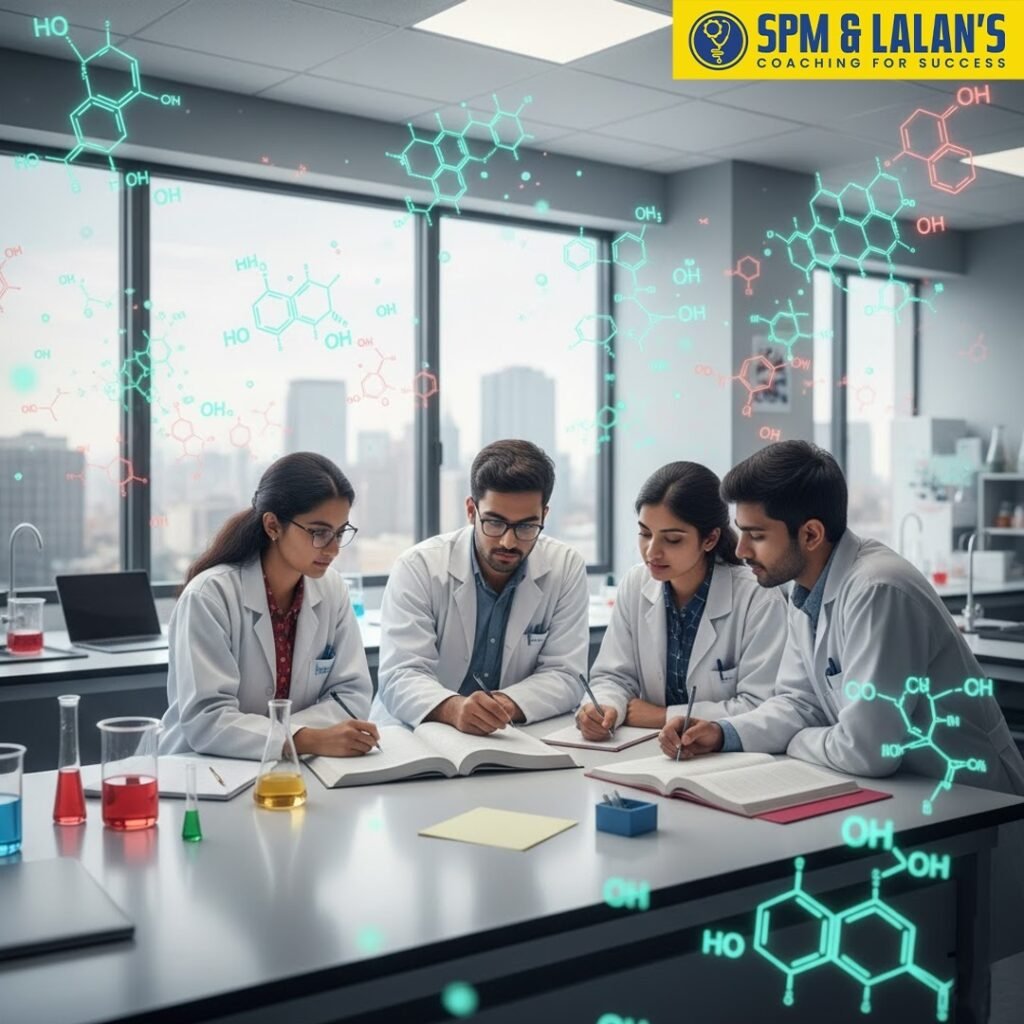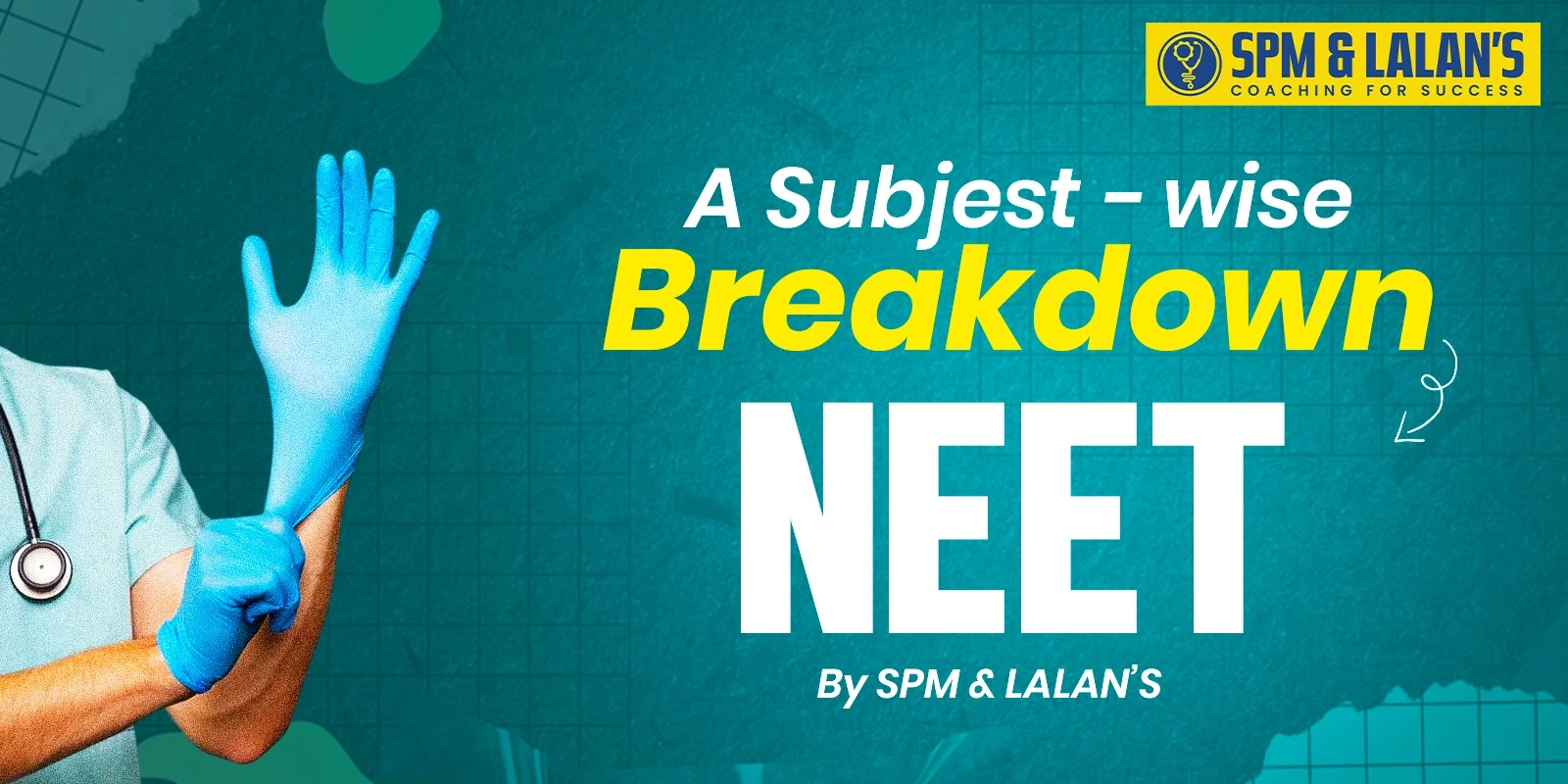If you are preparing for JEE Main 2025, understanding the JEE Main Chemistry Syllabus is essential. The syllabus is not just a list of topics it’s a roadmap that shapes your preparation strategy. Moreover, It tests your grasp of concepts, logical application, and numerical ability across Physical, Organic, and Inorganic Chemistry.
At SPM and Lalan’s coaching , we believe that mastering the JEE Main Chemistry Syllabus requires clarity, consistency, and a smart approach. So , let’s dive into the complete, chapter-wise breakdown of the syllabus and understand how to prepare effectively for each section.
Overview of JEE Main Chemistry Syllabus 2025
Understanding the JEE Main Chemistry Syllabus is essential for effective preparation. Similarly, for a comprehensive understanding of the JEE Main Mathematics Syllabus, refer to our detailed breakdown, which covers both Class 11 and Class 12 topics, ensuring a well-rounded preparation strategy.
- First , the Physical Chemistry – which includes Numerical and conceptual understanding.
- Second is Inorganic Chemistry – which is all about Conceptual and memory-based understanding.
- Third , Organic Chemistry – which includes Logical application and mechanism-based questions.
Hence , the syllabus tests both theoretical and practical understanding, ensuring you can solve both direct and application-based problems efficiently.
Physical Chemistry Syllabus for JEE Main 2025

Physical Chemistry lays the foundation for understanding molecular behavior, reactions, and energy changes. Therefore, it’s highly scoring when concepts are clear.
Key Topics Covered in Physical Chemistry:
| Chapter No. | Chapter Name | Important Subtopics |
| 1 | Some Basic Concepts in Chemistry | Matter and its nature; Dalton’s atomic theory; Concept of atom, molecule, element, compound; Laws of chemical combination; Atomic & molecular masses; Mole concept, molar mass; Percentage composition; Empirical & molecular formulae; Chemical equations & stoichiometry |
| 2 | Atomic Structure | Nature of electromagnetic radiation; Photoelectric effect; Hydrogen atom spectrum; Bohr model: postulates, energy & radius relations, limitations; Dual nature of matter, de Broglie relationship; Heisenberg uncertainty principle; Quantum mechanical model of atom; Atomic orbitals (1s, 2s); Quantum numbers (principal, angular, magnetic, spin); Shapes of s, p, d orbitals; Electron filling rules: Aufbau, Pauli, Hund; Electronic configuration and stability of half/full-filled orbitals |
| 3 | Chemical Bonding and Molecular Structure | Kossel-Lewis approach: ionic & covalent bonds; Ionic bonding: formation, factors, lattice enthalpy; Covalent bonding: electronegativity, Fajan’s rule, dipole moment; VSEPR theory & molecular shapes; Valence Bond Theory: hybridization, resonance; Molecular Orbital Theory: LCAO, bonding & antibonding orbitals, sigma & pi bonds, bond order, bond length, bond energy; Metallic bonding & hydrogen bonding |
| 4 | Chemical Thermodynamics | Fundamentals: system, surroundings, extensive & intensive properties, state functions, entropy; First law of thermodynamics: work, heat, internal energy, enthalpy, heat capacity; Hess’s law & enthalpies: bond dissociation, combustion, formation, atomization, sublimation, phase transition, hydration, ionization, solution; Second law: spontaneity, ΔS, ΔG, ΔG°, equilibrium constant |
| 5 | Solutions | Concentration terms: molality, molarity, mole fraction, percentage (by volume & mass); Vapour pressure, Raoult’s Law (ideal & non-ideal); Colligative properties: relative lowering of vapour pressure, depression of freezing point, elevation of boiling point, osmotic pressure; Determination of molecular mass using colligative properties; Van’t Hoff factor and its significance |
| 6 | Equilibrium | Concept of dynamic equilibrium; Physical equilibria: solid-liquid, liquid-gas, gas-gas, solid-gas; Henry’s Law; Chemical equilibrium: law of chemical equilibrium, equilibrium constants (Kp, Kc), ΔG & ΔG°, factors affecting equilibrium, Le Chatelier’s principle; Ionic equilibrium: weak & strong electrolytes, acid-base concepts (Arrhenius, Bronsted-Lowry, Lewis), ionization constants, pH scale, common ion effect, hydrolysis of salts, solubility products, buffer solutions |
| 7 | Redox Reactions and Electrochemistry | Concepts of oxidation & reduction, redox reactions, oxidation number, rules for assigning oxidation number, balancing redox reactions; Electrolytic & metallic conduction, conductance in solutions, molar conductivity, Kohlrausch’s law; Electrochemical cells: electrolytic & Galvanic cells, electrodes, electrode potential, emf, Nernst equation, relation of cell potential & Gibbs energy; Dry cells, lead accumulator, fuel cells |
| 8 | Chemical Kinetics | Rate of chemical reaction, factors affecting rate (concentration, temperature, pressure, catalyst); Elementary & complex reactions, order & molecularity; Rate law & rate constant; Differential & integral forms of zero & first-order reactions, half-life; Effect of temperature, Arrhenius theory, activation energy, collision theory (bimolecular gaseous reactions) |
So , try to focus on conceptual clarity rather than memorization. Practice numerical questions daily. Our expert mentors emphasize visualization and problem-based learning to ensure you understand the why behind every concept.
Inorganic Chemistry Syllabus for JEE Main 2025
Inorganic Chemistry tests your ability to recall, connect, and interpret chemical facts. Many students overlook this area, but it can be the highest-scoring if studied systematically.
Important Topics in Inorganic Chemistry:
| Section | Chapter | Key Concepts |
| Inorganic Chemistry | Classification of Elements & Periodicity in Properties | Modern periodic law, periodic table, s, p, d, f block elements, periodic trends: atomic & ionic radii, ionization enthalpy, electron gain enthalpy, valence, oxidation states, chemical reactivity |
| p-Block Elements | Groups 13–18: electronic configuration, trends in physical & chemical properties, unique behavior of first element in each group | |
| d- & f-Block Elements | Transition Elements: general introduction, electronic configuration, occurrence, properties (physical, ionization enthalpy, oxidation states, colour, magnetism, catalytic behaviour, complex formation, interstitial compounds, alloys), preparation, properties & uses of K₂Cr₂O₇ and KMnO₄; Inner Transition Elements: Lanthanoids (electronic configuration, oxidation states, lanthanoid contraction), Actinoids (electronic configuration, oxidation states) | |
| Coordination Compounds | Introduction: Werner’s theory, ligands, coordination number, denticity, chelation, IUPAC nomenclature, isomerism; Bonding: Valence bond theory, basic Crystal Field Theory, colour & magnetic properties, importance in qualitative analysis, metal extraction, biological systems | |
| Organic Chemistry | Purification & Characterization of Organic Compounds | Crystallization, sublimation, distillation, differential extraction, chromatography; Detection of N, S, P, halogens; Quantitative analysis (C, H, N, halogens, S, P); Calculation of empirical & molecular formulae |
| Some Basic Principles of Organic Chemistry | Tetravalency of carbon, hybridization, functional group classification, homologous series, isomerism (structural & stereoisomerism), nomenclature (trivial & IUPAC); Covalent bond fission, free radicals, carbocations, carbanions, electrophiles & nucleophiles; Electronic displacement: inductive, electromeric, resonance, hyperconjugation; Common reactions: substitution, addition, elimination, rearrangement | |
| Hydrocarbons | Alkanes: conformations, halogenation; Alkenes: geometrical isomerism, electrophilic addition, polymerization; Alkynes: acidic character, addition & polymerization; Aromatics: benzene structure, aromaticity, electrophilic substitution, Friedel-Crafts alkylation & acylation, directive influence | |
| Organic Compounds Containing Halogens | Preparation, properties, reactions, C–X bond nature, substitution mechanisms; Uses & environmental effects (chloroform, iodoform, freons, DDT) | |
| Organic Compounds Containing Oxygen | Alcohols: identification, dehydration mechanism; Phenols: acidic nature, electrophilic substitution, Reimer-Tiemann reaction; Ethers: structure; Aldehydes & Ketones: nucleophilic addition, reactivity, reactions (Grignard, oxidation, reduction, Cannizzaro, Aldol, Haloform), chemical tests; Carboxylic acids: acidic strength & factors | |
| Organic Compounds Containing Nitrogen | Amines: nomenclature, classification, identification, basic character; Diazonium salts: importance in synthetic organic chemistry | |
| Biomolecules | Carbohydrates: classification, monosaccharides (glucose, fructose), oligosaccharides (sucrose, lactose, maltose); Proteins: amino acids, peptide bonds, polypeptides, protein structure (primary–quaternary), denaturation, enzymes; Vitamins: classification & functions; Nucleic acids: DNA & RNA constitution, functions; Hormones: general introduction | |
| Principles Related to Practical Chemistry | Detection of extra elements (N, S, halogens) & functional groups (hydroxyl, carbonyl, carboxyl, amino); Preparation of inorganic compounds (Mohr’s salt, potash alum) & organic compounds (Acetanilide, p-nitroacetanilide, aniline yellow, iodoform); Titrimetric exercises: acids, bases, oxalic acid vs KMnO₄, Mohr’s salt vs KMnO₄; Qualitative salt analysis: cations (Pb²⁺, Cu²⁺, Al³⁺, Fe³⁺, Zn²⁺, Ni²⁺, Ca²⁺, Ba²⁺, Mg²⁺, NH₄⁺), anions (CO₃²⁻, S²⁻, SO₄²⁻, NO₃⁻, NO₂⁻, Cl⁻, Br⁻, I⁻); Experiments: enthalpy of CuSO₄ solution, enthalpy of neutralization, lyophilic/lyophobic sols, kinetic study of iodide & hydrogen peroxide reaction |
Additionally, our faculty recommends short, daily revisions of periodic trends and block elements. Also , students are trained to link concepts through comparative tables and quick recall charts.
Organic Chemistry Syllabus for JEE Main 2025
Organic Chemistry evaluates your logical reasoning and understanding of reaction mechanisms. Every year, around one-third of Chemistry questions come from Organic Chemistry.
Major Topics in Organic Chemistry:
| Chapter | Key Topics |
| Alcohols, Phenols, and Ethers | Preparation, properties, reactions, identification |
| Carboxylic Acids and Their Derivatives | Structure, acidity, reactions, and important compounds |
| Amines | Classification, preparation, reactions, identification |
| Aromatic Compounds | Benzene, aromaticity, electrophilic substitution, derivatives |
| Hydrocarbons | Alkanes, alkenes, alkynes, reactions |
| Biomolecules | Carbohydrates, proteins, nucleic acids, vitamins |
| Practical Organic Chemistry | Qualitative and quantitative analysis, detection of functional groups, and preparation of key compounds |
Hence , try to learn mechanisms, not reactions. Our mentors simplify complex reaction pathways through flowcharts and practical examples. Regular quizzes and organic mechanism workshops help solidify your concepts.
Deleted and Reduced Topics for JEE Main Chemistry 2025
NTA has streamlined the JEE Main Chemistry syllabus by removing outdated or overlapping topics. Here are the removed portions , which includes :
| Chapter Name | Deleted Topics |
| Some Basic Concepts in Chemistry | Physical quantities and their measurements, Precision and accuracy, Significant figures, S.I. Units, Dimensional analysis |
| States of Matter | Classification of matter (solid, liquid, gas); Gaseous state: Boyle’s law, Charles’s law, Graham’s law of diffusion, Avogadro’s law, Dalton’s law of partial pressure, Absolute scale of temperature, Ideal gas equation, Kinetic theory of gases (only postulates), Average, root mean square and most probable velocities, Real gases, compressibility factor, van der Waals equation; Liquid state: vapour pressure, viscosity, surface tension, effect of temperature (qualitative); Solid state: molecular, ionic, covalent, metallic solids, amorphous & crystalline solids, Bragg’s law, unit cell, lattices, packing (fcc, bcc, hcp), voids, unit cell calculations, imperfections, electrical & magnetic properties |
| Atomic Structure | Thomson and Rutherford atomic models and their limitations |
| Surface Chemistry | Adsorption (physisorption & chemisorption), Freundlich & Langmuir isotherms, adsorption from solutions; Catalysis (homogeneous & heterogeneous), enzyme catalysis & mechanism; Colloidal state: distinction among solutions, colloids, suspensions; classification: lyophilic, lyophobic, multi-molecular, macromolecular, associated colloids; Preparation & properties of colloids, Tyndall effect, Brownian movement, electrophoresis, dialysis, coagulation, flocculation, emulsions & characteristics |
| General Principles & Processes of Isolation of Metals (Metallurgy) | Modes of occurrence of elements, minerals, ores; Steps in extraction of metals (concentration, reduction, refining) with reference to Al, Cu, Zn, Fe; Thermodynamic & electrochemical principles in metal extraction |
| Hydrogen | Position in periodic table, isotopes, preparation, properties & uses; Physical & chemical properties of water & heavy water; Hydrogen peroxide: structure, preparation, reactions, uses; Hydrides: ionic, covalent, interstitial; Hydrogen as fuel |
| S-Block Elements | General introduction |
| P-Block Elements | Electronic configuration & trends; Anomalous properties of first element in each group; Important compounds (Na₂CO₃, NaOH, NaHCO₃); Industrial uses of lime, limestone, Plaster of Paris, cement; Biological significance of Na, K, Mg, Ca; Group-wise compounds: Boron & Al, borax, boric acid, diborane, BF₃, AlCl₃, alums; Group 14: catenation, allotropes & oxides of carbon, SiCl₄, silicates, zeolites, silicones; Group 15: N & P compounds, allotropic P, NH₃, HNO₃, PH₃, P halides; Group 16: Ozone, allotropic S, H₂SO₄; Group 17: HCl, acidic trend of hydrogen halides, interhalogen compounds, oxides & oxoacids; Group 18: Noble gases, fluorides & oxides of Xe |
| Environmental Chemistry | Atmospheric, water & soil pollution; Tropospheric pollutants: oxides of C, N, S; Hydrocarbons: sources, harmful effects & prevention; Greenhouse effect & global warming; Acid rain; Particulate pollutants: smoke, dust, smog, fumes, mist; Stratospheric pollution: ozone formation & breakdown, ozone depletion; Water pollution: pathogens, organic & chemical pollutants; Soil pollution: pesticides (insecticides, herbicides, fungicides); Pollution control strategies |
| Polymers | General introduction & classification; Polymerization methods: addition, condensation; Copolymerization, natural & synthetic, rubber & vulcanization; Important polymers: polythene, nylon, polyester, bakelite, with monomers & uses |
| Chemistry in Everyday Life | Chemicals in medicines: analgesics, tranquilizers, antiseptics, disinfectants, antimicrobials, anti-fertility drugs, antibiotics, antacids, antihistamines; Chemicals in food: preservatives, artificial sweetening agents; Cleansing agents: soaps & detergents, cleansing action |
Hence , try to Focus only on updated topics. Moreover, Our institute provides the revised JEE Main Chemistry Syllabus 2025 PDF and conducts dedicated sessions to cover only relevant chapters.
Chapter-Wise Weightage in JEE Main Chemistry 2025
| Chapter | Total Questions | Weightage |
| Mole Concept | 1 | 3.3% |
| Redox Reactions | 1 | 3.3% |
| Electrochemistry | 1 | 3.3% |
| Chemical Kinetics | 1 | 3.3% |
| Solution & Colligative Properties | 1 | 3.3% |
| General Organic Chemistry | 1 | 3.3% |
| Stereochemistry | 1 | 3.3% |
| Hydrocarbon | 1 | 3.3% |
| Alkyl Halides | 1 | 3.3% |
| Carboxylic Acids & Their Derivatives | 1 | 3.3% |
| Carbohydrates, Amino Acids & Polymers | 1 | 3.3% |
| Aromatic Compounds | 1 | 3.3% |
| Atomic Structure | 2 | 6.6% |
| Chemical Bonding | 2 | 6.6% |
| Chemical & Ionic Equilibrium | 2 | 6.6% |
| Solid-State & Surface Chemistry | 2 | 6.6% |
| Nuclear & Environmental Chemistry | 2 | 6.6% |
| Thermodynamics & Gaseous State | 2 | 6.6% |
| Transition Elements & Coordination Compounds | 3 | 9.9% |
| Periodic Table | 3 | 9.9% |
Moreover, this Weightage varies every year, but chapters like Chemical Bonding, Coordination Compounds, and Organic Mechanisms consistently hold higher marks. Prioritize them.
JEE Main Chemistry Preparation Tips 2025

- Concept over memorization: First , try to focus on understanding chemical logic.
- Daily practice: Secondly , Solve 20–30 Chemistry questions every day.
- Smart revision: Third , Use flashcards and chapter summaries weekly.
- Mock tests: Moreover, attempt as much as full-length mocks to build time efficiency.
- Mentorship at SPM and Lalan’s: Lastly, and most importantly, our one-to-one mentoring ensures that every student has a personalized strategy based on strengths and weak areas. For a detailed guide on effective Chemistry preparation strategies, check out our JEE Main Chemistry Preparation 2025.
Conclusion
The JEE Main Chemistry Syllabus 2025 is vast but conquerable with smart planning and expert guidance. With the right blend of conceptual clarity and daily problem-solving, students can turn Chemistry into their strongest subject.
At SPM and Lalan’s , we ensure that aspirants not only cover the syllabus thoroughly but also develop exam temperament and analytical accuracy. Our experienced faculty, regular tests, and mentorship programs help students achieve their IIT dreams with confidence.
FAQs
Q1. What is the JEE Main Chemistry Syllabus 2025 based on?
The JEE Main Chemistry Syllabus is based on Class 11 and 12 NCERT topics, covering Physical, Organic, and Inorganic Chemistry in a balanced way.
Q2. Has NTA changed the Chemistry syllabus for JEE Main 2025?
Yes, a few topics like Surface Chemistry and Environmental Chemistry have been removed to streamline the syllabus.
Q3. Which Chemistry section is most scoring in JEE Main?
Physical Chemistry is the most scoring due to its conceptual and numerical nature. However, consistent revision in Inorganic and practice in Organic Chemistry are equally vital.
Q4. How can I master Organic Chemistry for JEE Main?
Understand mechanisms instead of memorizing reactions. Practice NCERT questions, previous year problems, and attend doubt-solving sessions at SPM and Lalan’s.
Q5. How does SPM and Lalan’s help in JEE Chemistry preparation?
With top-notch faculty, one-to-one mentorship, and interactive problem-solving sessions, SPM and Lalan’s ensure complete conceptual clarity and exam readiness.



